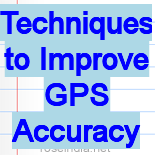Techniques to Improve GPS Accuracy
Introduction
GPS is the best navigation and tracking technology developed so far, with accuracy levels of within 4-20 meters or so of the actual position of the object being tracked. However many of the areas this technology is being used for need much better accuracy levels. This includes sectors like aviation. Research is on for improving the accuracy levels. Here is an overview of some of the add-on technologies that improve the accuracy of GPS readings.
Differential GPS
Differential GPS or DGPS brings the accuracy of readings to within 1-3 meters of the object, as compared to the 4-20 meters of normal GPS. DGPS works using a network of stationary GPS receivers. The difference between their predefined position and the position as calculated by the signals from satellites gives the error factor. This error component is then transmitted as a FM signal for the local GPS receivers, enabling them to apply the necessary correction to their readings.
This civilian system works parallel to a similar system run by the US Coast Guard on marine longwave radio in the coastal belt and other major waterways.
Wide Area Augmentation System
The Wide Area Augmentation System (WAAS) also works with ground reference stations to calculate the required correction. The correction message is then relayed to GPS receivers through additional geostationary orbits. WAAS is able to account for errors due to ionospheric disturbances and clock drifts.
WAAS is of great value to high-precision applications like GPS-based instrument approaches in aviation. For instance, WAAS can come to aid in situations such as poor visibility, precision landing and so on. WAAS is currently fully operational only in the US, however parallel developments are taking place in Europe and Japan.
Local Area Augmentation System
Local Area Augmentation System or LAAS uses similar correction data as WAAS. However LAAS uses a local source at a predefined location to transmit the data. The correction data is typically applicable within only a radius of 20-50 kilometer around the transmitter station.
Other Approaches
Other approaches include Exploitation of DGPS for Guidance Enhanacement (EDGE), which integrates DGPS with precision guided munitions like JDAM (Joint Direct Attack Munition) and CPGPS (Carrier Phase Enhancement) where 1.575 GHz carrier waves are used for additional clock signals.
WAGE (Wide Area GPS Enhancement) works by getting more accurate satellite clock and ephemeris data. However this requires special receivers.
Relative Kinematic Positioning (RKP) is another highly precise system with accuracy levels of within 10 centemeters of the actual position. RKP uses a combination of DGPS data, signal phase calculations and ambiguity resolution techniques, the entire processing work done in real time.
New automobile GPS applications often have add-ons like gyroscopes and speedometer pickup. This enables the computer to keep at the navigation by dead reckoning when terrain conditions, tunnels or tall buildings block the regular GPS signals. The principle is similar to that of internal navigation used in ships and aircraft.



